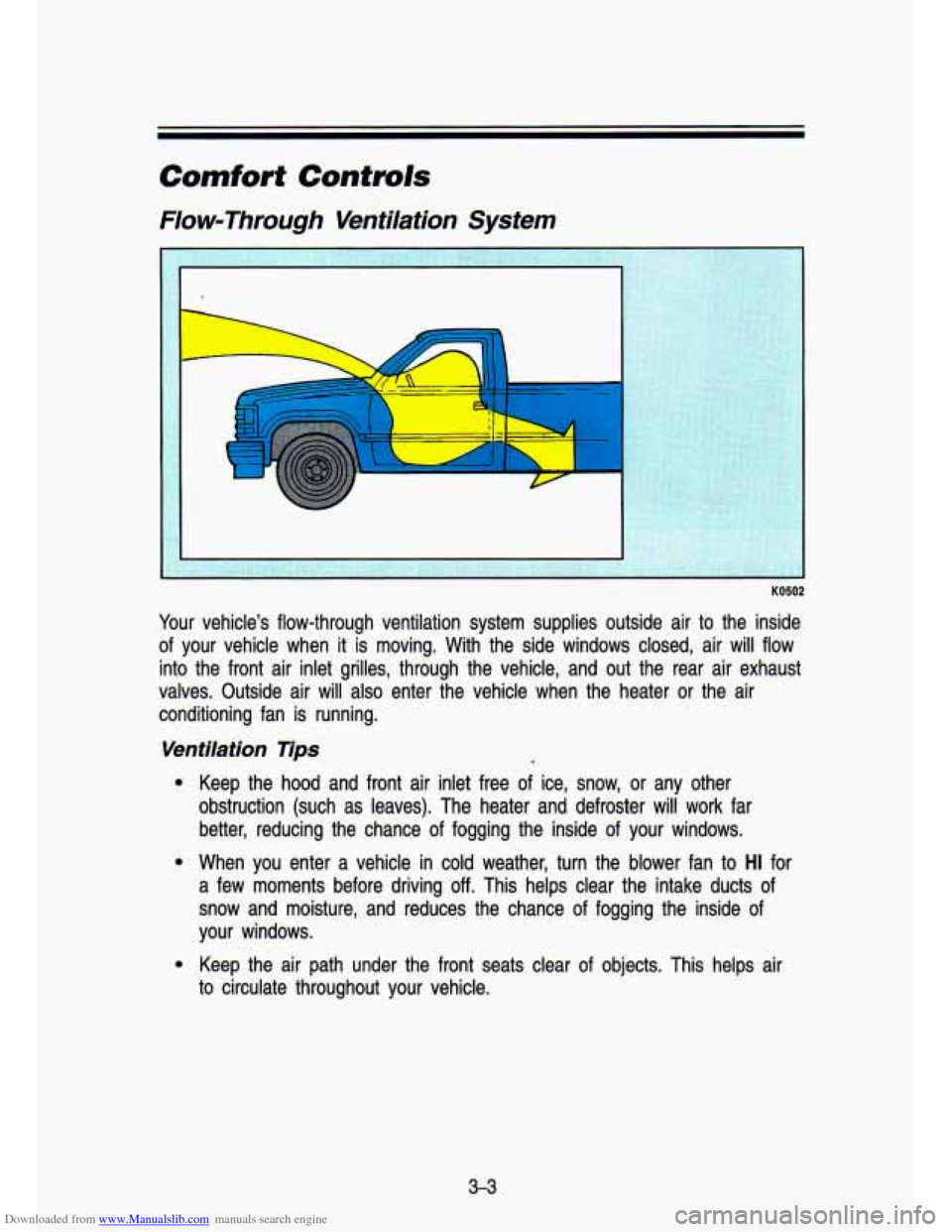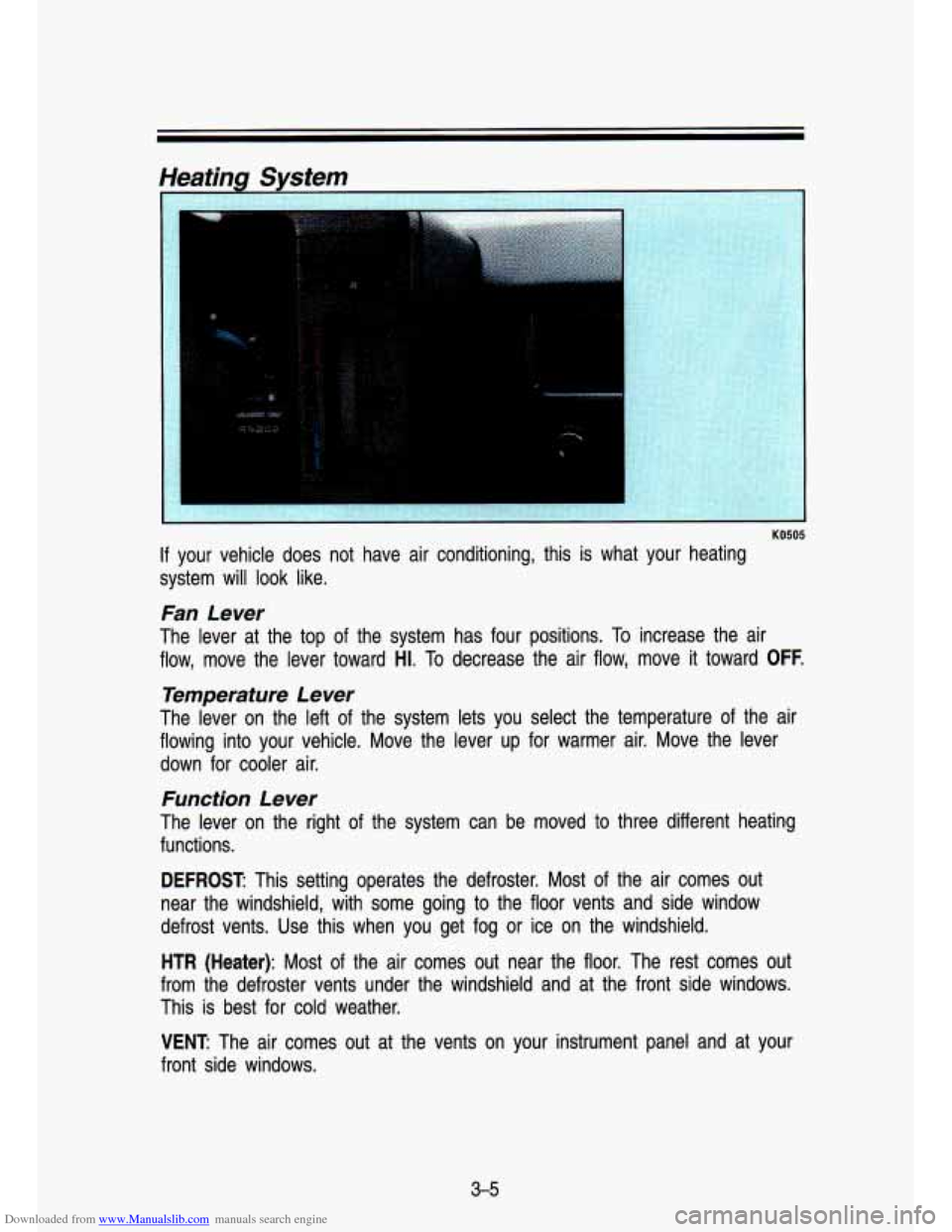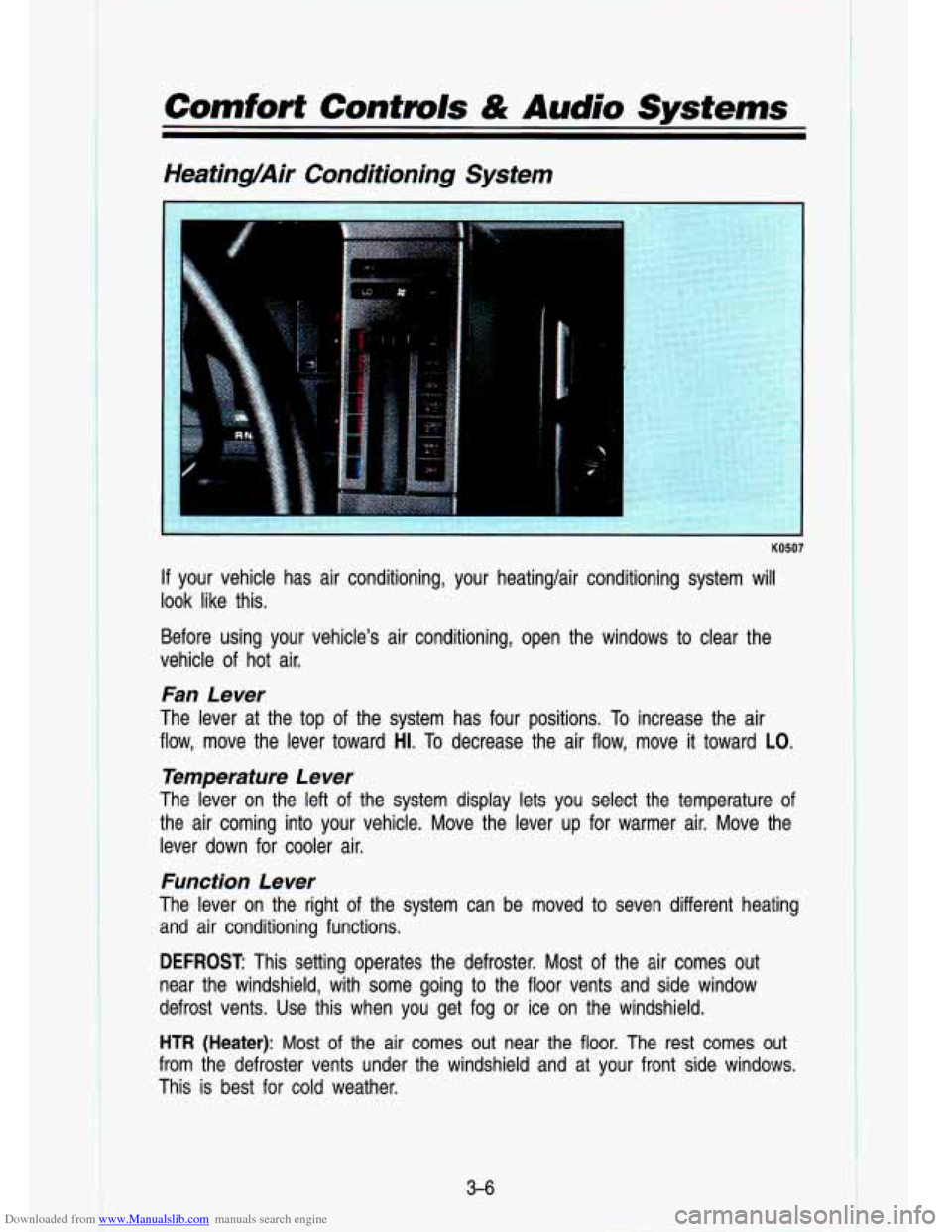1993 CHEVROLET S10 window
[x] Cancel search: windowPage 109 of 356

Downloaded from www.Manualslib.com manuals search engine Some vehicles have a storage area behind the seat.
K224,
PO1 84
Convenience Net (Extended Cab)
A convenience net may be provided for the rear cab to help keep\
small
items, like gloves and light clothing
in place during sharp turns or quick stops
and starts. The net is not designed to retain these items during off-road use.
The net is not for larger, heavier items. Store such things on the load \
floor
as far forward as you can.
Install the convenience net at the rear of your vehicle, just below the rear
window. Attach the upper loops to the retainers below the window (the label
should be visible in the upper passenger side corner). The convenience net
has a maximum capacity of
25 pounds (11 kg).
2-57
Page 131 of 356

Downloaded from www.Manualslib.com manuals search engine Comfort Controls
Flow-Through Ventilatr'on System
I
KO502
Your vehicle's flow-through ventilation system supplies outside air to\
the inside
of your vehicle when it
is moving. With the side windows closed, air will flow
into the front air inlet grilles, through the vehicle, and out\
the rear air exhaust
valves. Outside air will also enter the vehicle when the heate\
r or the air
conditioning fan is running.
Ventilation Tips
e
e Keep the hood and front air inlet free of ice, snow, or any other
obstruction (such as leaves). The heater and defroster will w\
ork far better, reducing the chance of fogging the inside of your wind\
ows.
When you enter a vehicle in cold weather, turn the blower fan
to HI for
a few moments before driving off. This helps clear the intake ducts of
snow and moisture, and reduces the chance of fogging the inside of
your windows.
Keep the air path under the front seats clear of objects. This helps air
to circulate throughout your vehicle.
3-3
Page 133 of 356

Downloaded from www.Manualslib.com manuals search engine Fan Lever
The lever at the top of the system has four positions. To increase the air
flow, move the lever toward
HI. To decrease the air flow, move it toward OFF.
Temperature Lever
The lever on the left of the system lets you select the temperature of the air
flowing into your vehicle. Move the lever up for warmer air. Move the leve\
r
down for cooler air.
Function Lever
The lever on the right of the system can be moved to three different heating
functions.
DEFROST: This setting operates the defroster. Most of the air comes out
near the windshield, with some going to the floor vents and side window
defrost vents. Use this when you get fog or ice on the windshield.
HTR (Heater): Most of the air comes out near the floor. The rest comes out
from the defroster vents under the windshield and at the front\
side windows.
This is best for cold weather.
VENT: The air comes out at the vents on your instrument panel and \
at your
front side windows.
3-5
Page 134 of 356

Downloaded from www.Manualslib.com manuals search engine Comforf Controls & Audio Systems
HeatingAir Conditioning System
K05ur
If your vehicle has air conditioning, your heatinglair conditioning \
system will
look like this.
Before using your vehicle’s air conditioning, open the window\
s to clear the
vehicle of hot air.
Fan Lever
The lever at the top of the system has four positions. To increase the air
flow, move the lever toward
H1. To decrease the air flow, move it toward LO.
Temperature Lever
The lever on the left of the system display lets you select the temperature of
the air coming into your vehicle. Move the lever up for warmer air. Move the
lever down for cooler air.
Function Lever
The lever on the right of the system can be moved to seven different heating
and air conditioning functions.
DEFROST This setting operates the defroster. Most of the air comes out
near the windshield, with some going to the floor vents and s\
ide window
defrost vents. Use this when you get fog or ice on the windshield.
HTR (Heater): Most of the air comes out near the floor. The rest comes out
from the defroster vents under the windshield and at your front
side windows.
This is best for cold weather.
3-6
Page 135 of 356

Downloaded from www.Manualslib.com manuals search engine VENT: The air comes out at the vents on your instrument panel and \
at your
front side windows.
BI-LEV NC: With this, outside air comes in through the heater floor vent and
the instrument panel vents. This setting is useful in cool weather with bright
sunlight.
NORM
NC: This setting cools the outside air. If you first used MAX, use
NORM as soon as the vehicle has cooled down,
so outside air will be going
through your vehicle.
MAX NC: This cools the air the fastest. Move the other lever all the \
way to
Cold. MAX lets in only a little air from the outside. You can use MAX at first
when it’s really hot outside and you need to cool
off quickly.
OFF: The blower is off, but air still will come from outlets at the front of your
vehicle. The system will try
to keep the air at the chosen temperature.
Engine Block Heater
If you use the optional engine block heater before starting your \
engine, your
heating system will produce warmer air faster, to heat the pas\
senger
compartment in cold weather. See “Engine Block Heater” in the Index.
Audio Systems
I CAUTION
A
Hearing damage frolm lloud noise is almost undetectable until it is too
late. Your
hearing can adapt to higher volmes of sound. So’und that
seems normal can
be loud an’d harmfull to your hearing. Jake
precaution’s by adjusting the volume control
on your radio to a safe
sound level before your hearing adapts to
it.
To help avoid hearing IOSS or damage:
* Adjust the volume control to the lowest setting.
Increase volume SliOWly until you hear comfortably and
clearlv.
- -
Your L-.CO@ audio system has been designed to operate easily and give
years of listening pleasure. But you will get the most enjoyment out of it if
you acquaint yourself with
it first. Find out what your Delco@ system can do
and how to operate all its controls, to be sure you’re getting the most out of
the advanced engineering that went into it.
3-7
Page 162 of 356

Downloaded from www.Manualslib.com manuals search engine c. -. .. .
Your Driving and the Road
Turn and lane change signals: Always signal when you plan to \
turn or
change lanes.
If necessary, you can use hand signals out the window: Left arm \
straight out
for a left turn, down for slow or about-to-stop, and up for a right turn.
Slowing down:
If time allows, tap the brake pedal once or twice in advance
of slowing or stopping. This warns the driver behind you.
Disabled: Your four-way flashers signal that your vehicle is disabled or is a
hazard. See “Hazard Warning Flasher’’ in the Index.
Traffic Officer
The traffic police officer is also a source of important information. The officer’s
signals govern, no matter what the traffic lights or other sig\
ns say.
The next part discusses some of the road conditions you may encounter.
Defensive Driving
The best advice anyone can give about driving is: Drive defens\
ively.
Please
start with a very important safety device in your vehicle: Buckle up.
(See “Safety Belts” in the Index.)
Defensive driving really means “be ready for anything.” On\
city streets, rural
roads, or freeways, it means “always expect the unexpected.”
Assume that pedestrians or other drivers are going to be careless and make
mistakes. Anticipate what they might
do. Be ready for their mistakes.
Expect children to dash out from behind parked cars, often followed by other
children. Expect occupants in parked cars to open doors into traffic. Watch for
movement in parked cars-someone may be about to open a door.
Expect other drivers to run stop signs .when you are on a through street. Be
ready to brake
if necessary as you go through intersections. You may not
have to use the brake, but if you
do, you will be ready.
If you’re driving through a shopping center parking lot where there are
well-marked lanes, directional arrows, and designated parking are\
as, expect
some drivers to ignore all these markings and dash straight toward one part
of the lot.
Pedestrians can be careless. Watch for them. In general, you m\
ust give way
to pedestrians even
if you know you have the right of way.
Rear-end collisions are about the most preventable of accidents. Yet they are
common. Allow enough following distance. It’s the best defens\
ive driving
4-8
Page 198 of 356

Downloaded from www.Manualslib.com manuals search engine Your Driving and the Road
..
C. .-, - ._ .
may tend to think you are going slower than you actually are.\
For example,
40 mph (65 km/h) might seem like only 20 mph (30 km/h). Obviously, this
could lead to serious trouble on a ramp designed for
20 mph (30 km/h)!
Driving a Long Distance
Although most long trips today are made on freeways, there are\
still many
made on regular highways.
Long-distance driving on freeways and regular highways is the s\
ame in some
ways. The trip has to be planned and the vehicle prepared, yo\
u drive at
higher-than-city speeds, and there are longer turns behind the \
wheel. You’ll
enjoy your trip more if you and your vehicle are in good shape. Here are
some tips for a successful long trip.
Before Leaving on a Long Trip
Make sure you’re ready. Try to be well rested. If you must start when you’re
not fresh-such as after a day’s work-don’t plan to make too many miles
that first part of the journey. Wear comfortable clothing and shoes you can
easily drive in.
Is your vehicle ready for a long trip? If you keep it serviced and maintained,
it’s ready to go.
If it needs service, have it done before starting out. Of
course, you’ll find experienced and able service experts in \
your vehicle’s
dealerships all across North America. They’ll be ready and w\
illing to help
if
YOU
Her1
0
need it.
ire
Some things you can check before a trip:
Windshield Washer Fluid:
Is the reservoir full? Are all windows clean
inside and outside?
Wiper Blades: Are they in good shape?
Fuel, Engine Oil, Other Fluids: Have you checked all levels?
Lights: Are they all working? Are the lenses clean?
Tires: They are vitally important to a safe, trouble-free trip.\
Is the tread
good enough for long-distance driving? Are the tires all inflat\
ed to the
recommended pressure?
Weather Forecasts: What’s the weather outlook along your rout\
e? Should you delay your trip
a short time to avoid a major storm system?
Maps:
Do you have up-to-date maps?
4-44
Page 207 of 356

Downloaded from www.Manualslib.com manuals search engine - I- :_
A1480028
If you are stopped by heavy snow, you could be in a serious sit\
uation. You
should probably stay with your vehicle unless you know for sur\
e that you are
near help and you can hike through the snow. Here are some t\
hings to do to
summon help and keep yourself and your passengers safe: Turn o\
n your
hazard flashers. Tie a red cloth to your vehicle to alert police that you’ve
been stopped by the snow. Put on extra clothing or wrap a blanket around
you. If you have no blankets or extra clothing, make body ins\
ulators from newspapers, burlap bags, rags, floor mats-anything you can wrap \
around
yourself or tuck under your clothing to keep warm.
You can run the engine
to keep warm, but be careful.
I
I
Snow can trap exhaust gases under your vehicle. This can cause\
deadly CO (carbon monoxide) gas
to get inside. CO could overcome
you and kill you. You can’t see
it or smell it, so you might not know
it is in your vehicle. Clear away snow from around the base of your
vehicle, especially any that is blocking your exhaust pipe. And check
around again from time to time to be sure snow doesn’t collect there
Open
a window just a little on the side of the vehicle that’s away
from the wind. This will help keep
CO out. I
4-53